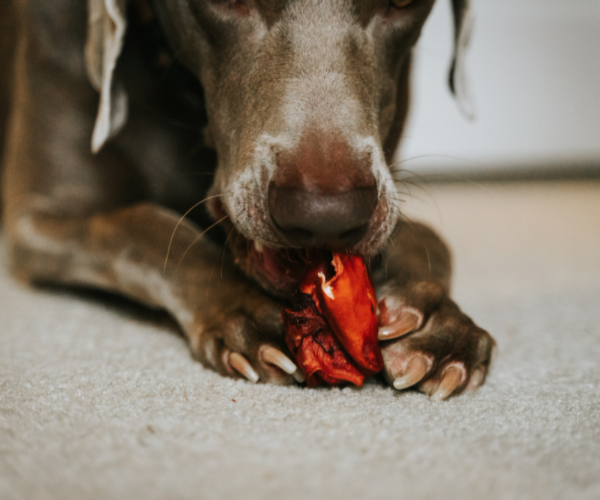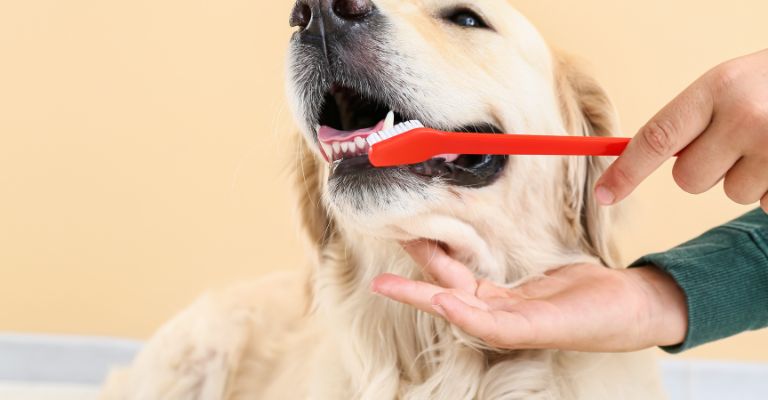Did you know that bones play a crucial role in promoting dental health in a raw dog food diet? Many dog owners are turning to this natural and nutritious diet for their furry companions, and for good reason. The act of chewing on bones not only satisfies a dog’s natural instinct, but it also provides a multitude of benefits for their oral hygiene. In this article, we will explore the importance of bones in promoting dental health and how they can contribute to your dog’s overall well-being on a raw food diet. So, if you want to ensure your dog has strong teeth and a healthy mouth, keep reading to discover the role of bones in their diet!

Introduction
If you are a dog owner looking to provide the best possible diet for your furry friend, you may have heard of the raw dog food diet. This diet consists of feeding your dog raw, uncooked meats, fruits, and vegetables. One key aspect of the raw dog food diet is the inclusion of bones. In this article, we will explore the benefits of a raw dog food diet, specifically focusing on the role of bones in promoting dental health. We will also discuss the types of bones suitable for this diet, the risks and guidelines for feeding bones, and how to supplement bone content in a raw dog food diet. Additionally, we will provide considerations for specific dog breeds and emphasize the importance of consulting with a veterinarian.
Benefits of a Raw Dog Food Diet
Nutritional Value of Raw Dog Food
Feeding your dog a raw diet can provide numerous nutritional benefits. Raw dog food is minimally processed, allowing the essential nutrients to remain intact. Dogs are carnivorous animals, and a raw diet closely mimics their natural diet in the wild. By feeding your dog raw food, you are providing them with high-quality proteins, healthy fats, and a variety of vitamins and minerals. This can lead to improved overall health, increased energy levels, and better digestion.
Improvement in Skin and Coat Health
One of the noticeable benefits of a raw dog food diet is the improvement in skin and coat health. Raw food is rich in omega-3 fatty acids, which help promote a shiny coat, reduce shedding, and alleviate dry and itchy skin. Additionally, the balanced nutrition provided by a raw diet can help prevent skin conditions and allergies, leading to a healthier and happier pup.
Reduction in Allergies and Sensitivities
Many commercial dog foods contain fillers, preservatives, and artificial ingredients that can trigger allergies and sensitivities in dogs. By switching to a raw dog food diet, you eliminate these potential allergens and provide your dog with a clean and natural diet. Raw food is easier to digest, which can help alleviate digestive issues and reduce the occurrence of food allergies and sensitivities. This can positively impact your dog’s overall well-being and contribute to a stronger immune system.
Role of Bones in Dental Health

Mechanical Cleaning Action
One of the key benefits of feeding bones in a raw dog food diet is their mechanical cleaning action. When dogs chew on bones, the natural grinding and chewing motion help remove food particles and debris from their teeth. This action acts similarly to a toothbrush, helping to keep their teeth clean and preventing the buildup of plaque and tartar. Regular bone chewing can contribute to maintaining good oral hygiene and preventing dental diseases.
Stimulation of Saliva Production
Chewing on bones stimulates saliva production in dogs. Saliva plays an essential role in maintaining oral health as it helps neutralize acids in the mouth, washes away food particles, and provides a natural defense against bacteria. The increased saliva production while chewing bones can aid in the prevention of tooth decay and gum disease.
Natural Teeth Cleaning
In addition to the mechanical cleaning action and stimulation of saliva production, the natural texture and structure of bones can help scrub the teeth and remove plaque and tartar. Raw bones have a slightly abrasive surface that can act as a natural toothbrush, gently cleaning the teeth and maintaining their whiteness. Regular bone chewing can contribute to a healthier and cleaner smile for your beloved furry friend.
Prevention of Plaque and Tartar Build-up
The accumulation of plaque and tartar on dogs’ teeth can lead to various dental issues, including bad breath, gum disease, and tooth loss. Feeding bones as part of a raw dog food diet can help prevent the buildup of plaque and tartar, reducing the risk of these dental problems. The mechanical action of chewing bones and the natural cleaning properties of bones contribute to maintaining good oral hygiene, promoting healthy teeth and gums.
Types of Bones Suitable for a Raw Dog Food Diet
Raw Meaty Bones (RMBs)
Raw meaty bones, also known as RMBs, are a staple in a raw dog food diet. These bones are typically covered in muscle meat, tendons, and ligaments, providing excellent nutritional value to your canine companion. RMBs include chicken wings, turkey necks, and beef ribs. The meat and connective tissues on these bones offer a balanced combination of nutrients, while the act of chewing helps keep your dog’s teeth and gums clean.
Edible Bones
Edible bones are another type of bone suitable for a raw dog food diet. These bones are soft and can be safely consumed by dogs. Examples of edible bones include chicken necks and chicken backs. Edible bones provide a great source of calcium and phosphorus, essential minerals for your dog’s bone and teeth health. It is important to choose bones that are appropriate for your dog’s size to ensure safe consumption.
Recreational Bones
Recreational bones are large, weight-bearing bones that are purely intended for recreational chewing. These bones, such as beef marrow bones or knucklebones, are typically given to dogs as a form of mental stimulation and enrichment. While recreational bones may not provide the same nutritional value as RMBs or edible bones, they can still contribute to good dental health by promoting chewing and keeping your dog entertained.
Weight-Bearing Bones
Weight-bearing bones, like beef femur bones or beef shank bones, can also be included in a raw dog food diet. These bones are dense and contain marrow, providing your dog with essential minerals and nutrients. The act of chewing on weight-bearing bones helps exercise the jaw muscles, promote clean teeth, and stimulate saliva production. However, it is crucial to offer appropriate-sized weight-bearing bones to prevent any risk of tooth fractures.
Risks and Guidelines for Feeding Bones
Choking and Dental Injuries
While there are many benefits to feeding bones, it is important to be aware of the potential risks associated with bone consumption. Dogs can sometimes be overzealous chewers, leading to situations where bones are swallowed whole or become lodged in their throat, causing choking. Additionally, bones can occasionally cause dental injuries, such as fractured teeth or gum abrasions. Therefore, it is crucial to supervise your dog while they are chewing bones and choose bones that are appropriate for their size and chewing behavior.
Digestive Issues
Some dogs may experience digestive issues when first transitioning to a raw dog food diet, including bone consumption. Dogs with sensitive stomachs or those who are not accustomed to eating bones may experience diarrhea or constipation. It is important to introduce bones gradually and monitor your dog’s digestion. If any issues arise, you may need to adjust the type or amount of bones you are feeding.
Precautions and Guidelines
To minimize the risks associated with feeding bones, there are several precautions and guidelines to follow:
- Always supervise your dog while they are chewing bones to prevent choking or dental injuries.
- Choose bones that are size-appropriate for your dog, considering their breed, age, and chewing behavior.
- Avoid cooked bones, as they can splinter and pose a threat to the digestive system.
- Do not give small or brittle bones to large, powerful chewers, as they can easily break them.
- If your dog has any existing dental issues or is prone to gastrointestinal problems, consult with your veterinarian before incorporating bones into their diet.
Monitoring Chewing Behavior
Regularly monitoring your dog’s chewing behavior is essential when feeding bones. If your dog is struggling to chew a bone, you may need to reassess the size or type of bone you are providing. It is also important to observe how your dog chews and ensure they are not breaking bones into sharp pieces. If you notice any abnormal chewing patterns or signs of discomfort, it is best to consult with your veterinarian.
Supplementing Bone Content in a Raw Dog Food Diet
Bone Meal
If you are unable to provide whole bones for your dog or prefer not to feed bones directly, bone meal can be a suitable alternative. Bone meal is made from finely ground animal bones and provides a concentrated source of minerals, including calcium and phosphorus. Incorporating bone meal into your dog’s diet can help ensure they receive adequate bone content without the need for whole bones. However, it is essential to consult with your veterinarian to determine the appropriate amount to supplement based on your dog’s specific needs.
Calcium Supplements
Calcium supplements can also be used to supplement bone content in a raw dog food diet. These supplements come in various forms, such as powder or chewable tablets, and can be added to your dog’s meals. Calcium is a vital mineral for bone health and should be included in the right proportion in your dog’s diet. Again, consulting with your veterinarian is crucial to determine the correct dosage for your dog based on their dietary requirements.
Vegetable and Fruit Alternatives
While bones are an excellent source of essential minerals, they are not the only option. Some vegetables and fruits can also provide alternative sources of calcium and other nutrients. Leafy greens, such as spinach and kale, contain calcium and can be added to your dog’s raw diet. Additionally, foods like broccoli, sweet potatoes, and oranges can contribute to a well-rounded nutritional profile. When supplementing bone content with vegetables and fruits, it is important to research appropriate serving sizes and consider the specific nutritional needs of your dog.
Considerations for Specific Dog Breeds
Small Breed Dogs
Small breed dogs, such as Chihuahuas, Pomeranians, and Yorkshire Terriers, have smaller jaws and are generally more prone to dental issues. When feeding bones to small breed dogs, it is crucial to offer appropriately sized bones to prevent any risk of choking or dental injuries. Edible bones, such as chicken necks or backs, can be suitable options for small breed dogs, as they are soft and easier to chew.
Large Breed Dogs
Large breed dogs, such as Labrador Retrievers, German Shepherds, and Great Danes, have larger jaws and stronger chewing capabilities. When feeding bones to large breed dogs, you can opt for larger bones, like beef femur bones or turkey drumsticks, that provide a satisfying chewing experience. However, it is still important to monitor your dog while chewing and ensure they are not breaking bones into sharp pieces.
Toy and Miniature Breeds
Toy and miniature breeds, such as Poodles, Maltese, and Shih Tzus, require special attention when it comes to bone consumption. These small dogs often have delicate teeth and jaws, making them more susceptible to dental injuries. Offering softer bones, such as chicken wings or turkey necks, can be a suitable option for toy and miniature breeds. It is essential to choose bones that are proportionate to their size and monitor their chewing behavior closely.
Senior Dogs
Senior dogs may have specific dental concerns, such as missing teeth or gum sensitivity. While bones can still be beneficial for their oral health, it is important to take into account any existing dental issues. Offering softer bones or incorporating bone meal or calcium supplements into their diet can provide the necessary nutrients without placing too much stress on their aging teeth and gums. Consulting with your veterinarian is especially important for senior dogs to ensure their specific needs are met.
Consultation with a Veterinarian
Before starting your dog on a raw dog food diet that includes bones, it is crucial to consult with a veterinarian. They can assess your dog’s specific nutritional needs, evaluate any existing dental issues, and provide guidance on incorporating bones into their diet safely. A veterinarian can also recommend appropriate bone sizes and types based on your dog’s breed, age, and overall health. Regular check-ups and dental cleanings are essential to maintain optimal oral health for your dog.
Conclusion
A raw dog food diet that includes bones can provide numerous benefits for your furry friend’s overall health and dental hygiene. The mechanical action of chewing bones helps keep their teeth clean and promotes healthy gums. By choosing the right types of bones and following proper guidelines, you can minimize the risks associated with bone consumption. However, it is crucial to consult with a veterinarian to ensure your dog’s specific needs are met and to receive professional guidance. Remember, a healthy mouth leads to a healthier and happier dog.


